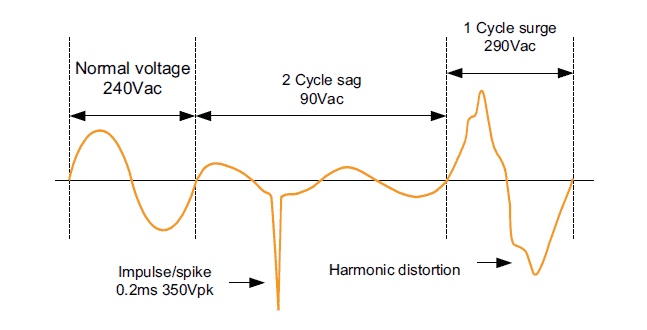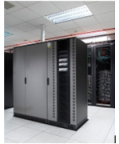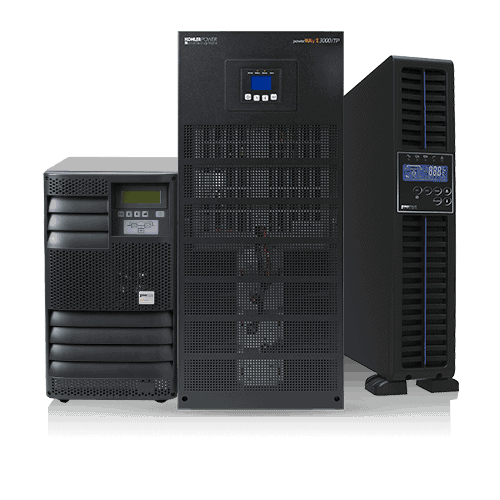Today, a typical organisation’s performance is only as good as its ICT resource – which depends just as critically on the quality and continuity of its power supply. Accordingly, such resources, which can range from large data centres to small IT rooms, are usually protected with a UPS system.
However, simply sourcing a UPS of suitable capacity isn’t necessarily enough to provide the level of protection that the facility needs. What happens if an extended blackout of several hours or more occurs?
Or if the mains input supply is subject to elevated levels of electrical noise or interference? In this article, we look at the factors to consider when accurately matching a power backup system to your particular data facility’s real needs. We can start by realising that power supply issues divide into long-term blackouts of extended duration, and short term problems such as transients, noise, brownouts and brief-duration blackouts.
Long-term blackouts – using generators
The long-term blackouts need special consideration because a UPS alone is never sufficient to guarantee cover. No matter how much the battery autonomy, a blackout of longer duration is always a possibility. Some facilities can tolerate this provided they can shut down safely, but most – especially if the system is processing on-line transactions – must continue running under all circumstances.
If the facility is ‘shut-down tolerant’ then it can survive with a UPS alone. During short term blackouts, the UPS simply switches its inverter to battery power on detection of utility supply failure. If power is restored well within the battery autonomy, the inverter is switched back to the incoming mains supply. The load has enjoyed uninterrupted operation, with complete protection from the temporary problem.
However, if the blackout period starts to threaten the battery autonomy, the UPS has no choice but to signal the load, allowing it to shut down gracefully in the remaining battery time. System hardware and data has been protected from damage, although the organisation suffers from lack of ICT resource.
If loss of this resource is unacceptable, the only solution is a UPS in combination with a backup generator, which, with sufficient fuel, can outlast any blackout.
Such generator-UPS combinations need reliable communications between the generator, UPS and critical load, as well as a suitable control system on the generator. During short-duration blackouts, the UPS uses its battery power to avoid unnecessary generator start-ups. If a blackout becomes extended, the UPS signals the generator through an Automatic Mains Failure (AMF) panel to start up. The UPS battery autonomy allows the generator to come up to speed and synchronises with the UPS’s voltage output, while the load suffers no power interruption. Once the generator is on line, the UPS takes its power to feed the load and recharge its batteries.
When the UPS detects restoration of mains power, it typically waits for a few minutes before switching back to the mains. This is to ensure that the power is sustained rather than the temporary result of, a utility company fault location procedure for example.
The generator itself must be adequately prepared in several aspects to perform successfully as a power backup component. It must have an electronic governor to regulate the engine speed and therefore the alternator output frequency, to ensure sufficient speed of response and accuracy. Mechanical governors are lower-cost, but lack the responsiveness, accuracy and stability needed by the UPS and critical load.
If the generator’s output frequency is outside the UPS’s critical limits, or is changing too fast (excessive slew rate), the UPS will not be able to synchronise. It will also generate a warning that in the event of a fault the load will not be transferred from the UPS to the raw generator supply.
To avoid such problems, it is important to inform the generator supplier that their equipment is intended for use with a UPS, and ensure that it is designed and tested accordingly.
UPS topologies
While the UPS plays its essential part in securing blackout backup appropriate to an application, its role in assuring power quality during normal utility mains supply is equally as important. Different topologies, with varying impacts on power quality, are available. Similar to the ‘generator or not’ discussion, the ‘best’ solution is the one that makes most sense for the target application.
In some applications, for example, power quality is not seen as a critical issue, either because the equipment is resilient to transients, noise and other problems, or the operators have complete faith in the quality of the incoming power supply. In such cases, an ‘offline’ UPS configuration, as shown in Fig.1, may be considered as most appropriate. The key point is that during normal operation, the critical load is directly exposed to raw power, flowing from the mains through the bypass line and static switch.
While there may be some transient suppression and radio-frequency filtering in the bypass circuit, protection is not inherent in an off-line UPS design. If the mains supply transgresses preset limits, or fails, the load is transferred to the inverter output.
Off-line designs are attractive in some circumstances because of their high efficiency, as the UPS components are bypassed during normal operation. Their capital cost may also be reduced due to use of lower-rated components. However they are not viable in most applications, where sensitive ICT equipment simply cannot be exposed to raw mains supplies.
Instead, these sensitive applications need an online UPS as shown in Fig.2. During normal mains operation, the incoming supply is fed through the UPS rectifier and inverter components, which means that the load receives processed power at all times. These components act as a barrier to mains-borne noise and voltage transients, while also providing a well-regulated output voltage.
Additionally – and unlike the off-line design – any transfer between mains supply and UPS battery is entirely invisible to the load, with no break in power.
Conclusion
Above, we have seen how consideration must be given to both extended power blackouts and power aberrations during normal mains operation. The best possible protection, which is essential to most mission-critical applications, comes from a power backup system comprising an on-line UPS and on-site generator. Cost saving
compromises as described can be made, but only if the site operators are entirely confident that their load will not be exposed to unacceptable risk as a result. The possible consequences of inadequate protection could far outweigh any savings made through reduced power backup specifications.






